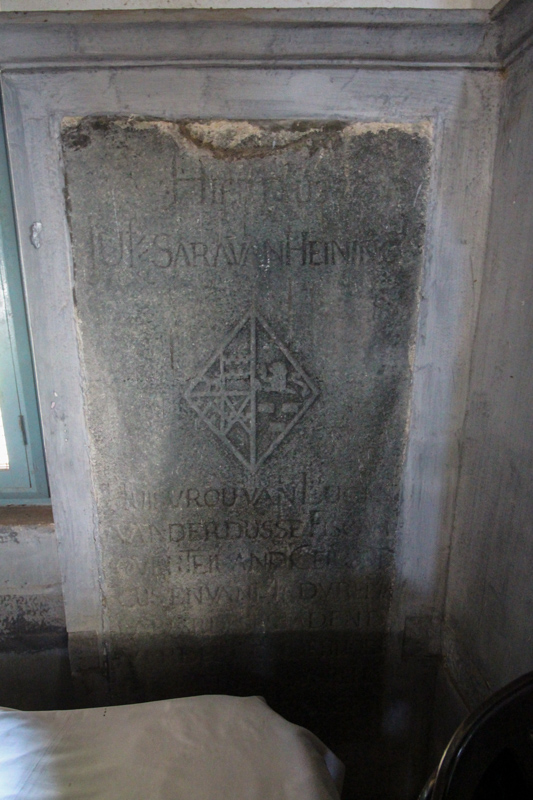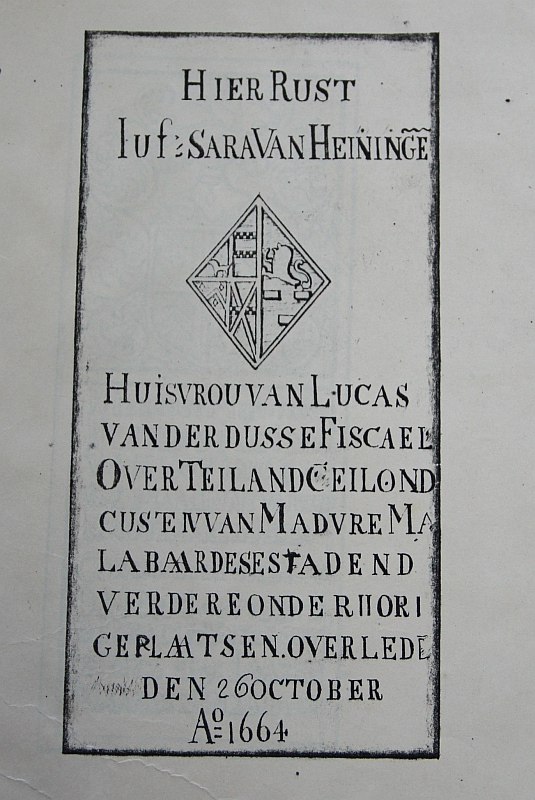Fort Kochi - Sara van Heiningen
In the wall of the St. Francis church in Kochi is the tombstone that Lucas van der Dussen had made in memory of his Sara. Sara was given the dubious honor of being the first Dutch woman to die in Kochi and her stone is the oldest known Dutch tombstone in this area on the Malabar coast.
Besides the fact that the tombstone says that she was the wife of Lucas van der Dussen and died on October 27, 1664, we know nothing about Sara van Heiningen. Actually, that's pretty remarkable. A Dutch genealogist has made the family tree of the well-known Delft family Van der Dussen and also mentions Lucas. He is said to have married Sara van Heiningen who was born on 5 May 1635 in Rouen (France) and would be the niece of his first wife who bore the same name: Sara van Heiningen[i]. He literally copied it from a book that came out in 1944[ii] and that author also literally copied it from a book from 1733[iii]. These authors readily admit to having received the family history of the Van der Dussens in this way. Theoretically, they could have found it in a family Bible and the information could be correct. Only that can no longer be verified, because the baptismal data from Rouen from that time have not been preserved. Despite the Dutch name and a very extensive search, no trace can be found of both Saras and the records of the marriages have not been found.
Sara did come, together with Lucas, from the Netherlands to Asia. The daily register of Batavia from 1664 mentions on 8 June 1664 that the merchant Lucas van Dussen and his family had arrived in Batavia with the ship Outshoorn of the Amsterdam chamber. That seems to indicate that he had more family with him than just his wife. The ship had departed from Texel on 12 December 1663 and had been at the Cape of Good Hope for two weeks. The journey had gone very well and only one crew member had died along the way. In addition to the 114 seafarers, there were 40 soldiers and 15 passengers on board.[iv] Sara and Lucas had plenty of time to prepare for the trip, because Lucas had re-entered the service of the VOC on 21 August 1663 after he had returned from the Indies in 1662. [v] After a short period of recovery in Batavia, the couple left in September with the Mars to Colombo and on to Cochin. This voyage went less smoothly, because the accompanying ship the Brouwershaven ran aground near Bantam and had to be pulled loose by the sent Tertholen. [vi] All things considered, given the time, it is possible that Sara died shortly before her arrival in Cochin on board of the ship and never set foot in Cochin. But she may have died just after arriving in Cochin. In any case, she was buried in St. Francis Church.
 Tombstone of Sara van Heiningen (photo René ten Dam, 2020)
Tombstone of Sara van Heiningen (photo René ten Dam, 2020)
In contrast to the funerary monument for Balthasar de Meter, the tombstone for Sara van Heijningen is provided with decorations in the form of a family coat of arms. Until the seventeenth century, women usually had a diamond-shaped coat of arms, with the coat of arms of the husband depicted on the right. It was not unusual for a family coat of arms to be invented to increase the prestige, but the coat of arms is real. On the tombstone is the alliance coat of arms of Sara van Heijningen and her husband. On the right we see a lion from Sara's coat of arms. In one of the left planes, we see a hunting dog from the coat of arms of Van der Dussen. However, the stone is quite weathered, which has blurred details. The text on the tombstone reads:
Hier Rust Juf. Sara Van Heininge Huisvrou van Lucas van der dusse Fiscael Over Teiland Ceilon Dcuste van Madure Malabaar dese stad end verdere onderhorige plaatsen. Overleden den 26 october Ao 1664
In translation: Here Rests Miss. Sara Van Heininge Housewife of Lucas van der dusse Fiscal on the island of Ceylon, the coast of Madure, Malabar this town and subordinate places. Died on 26 October Ao 1664.
 Drawing of the tombstone
Drawing of the tombstone
Lucas continued to live in Cochin and eventually became commander of Malabar. On 14 December 1668, he was allocated a plot of land in block H no. 16 to build a house. [vii] It seems that he wanted to stay in Cochin, but he got into trouble with his boss Rijklof van Goens and complained to the governor-general. An appointment as director of the trading post Persia followed from where he returned to Batavia in 1672. On 8 October 1672, he was commander of the ships that were sent from Batavia to protect the so-called North Sailors (from Japan) against the French fleet. In the daily register of Batavia was written on 24 July, 1673: [translated]" Around midnight, the honourable Lucas van der Dussen, former director in Persia, died here suddenly of an illness. And buried on 23 Sunday afternoon, after the sermon."
"Money marries money" is an old Dutch saying. Lucas came from a well-to-do family of brewers who also fulfilled many public functions such as mayor, aldermen and directors of the Delft chamber of the VOC. Sara will therefore also have come from a well-to-do family and it is therefore all the more strange that her name only lives on because of a stone in a church wall far from her country of origin.
Notes
[i] www.nagtegaal.org/wp-content/uploads/2014/11/watermarked-Dussen-van-der-I-sep.-20141.pdf
[ii]W. Wijnaendts van Resandt, De Gezaghebbers der Oost-Indische Compagnie op hare Buiten Comtoiren in Azië (Amsterdam 1944), blz. 181
[iii] David van Hoogstraten en Jan Lodewijk Schuer, tiende deel. Groot Algemeen Historisch Geographisch, Genealogisch en oordeelkundig woordenboek
[iv] DAS register
[v] Lucas van der Dussen, son of Hugo Lucaszn Hotels van der Dussen and Alida Maertensdr Hogenhoek, was christened in Delft on 16 September 1620. He went as a sub-merchant with the Crowned Lion in 1655 to the Indies, became rear admiral at night and fiscal of the Goa fleet on 8 September 1656, sailed often from Batavia to the coast of Malabar and Ceylon to buy rice and others merchandise, fiscal on Ceylon 1661. Repatriated in 1662. He came from a family that was mated to various directors of the VOC and men like Admiral Adam Westerwolt and Cornelis Haga, the first Dutch Ambassador in Istanbul.
[vi] Dag register Batavia 1664 f 368
[vii] NA 1.11.06.11.003 scan 0024
- Last updated on .


